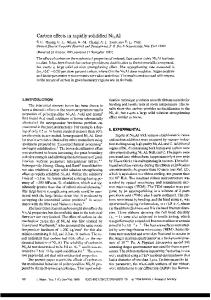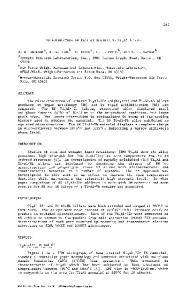A Microstruciure Investigation on Rapidly Solidified Ni 3 Al Containing Boron
- PDF / 2,297,762 Bytes
- 5 Pages / 417.6 x 639 pts Page_size
- 18 Downloads / 324 Views
A MICROSTRUCIURE INVESTIGATION ON RAPIDLY SOLIDIFIED Ni3 Al CONTAINING BORON
K.M.CIIANG, S.C.HUANG, AND A.I.TAUB General Electric Corporate Research and Development, 12301 USA
Schenectady,
New York,
ABSTRACT A small amount of boron addition in rapidly solidified Ni Al has been found to yield remarkable improvements in bolh room-temperature strength and ductility. In this study, the microstructure of melt-spun Ni 3 Al ribbons with various boron modifications ranging from 0 to 6.0 at% was investigated in detail by using transmission electron microscopy. All alloy compositions studied reveal a completely ordered fcc L1 2 matrix phase, in which polygonized dislocation networks and subgrain boundaries are observed. The boron-free Ni 3 Al contains a dispersion of an Al-rich martensitic phase consisting of alternate twins. The boron addition tends to suppress the formation of the martensitic phase, but excessive boron (> 2.0 at%) causes the precipitation of M2 3 B 6 type borides. INTRODUCTION The intermetallic phase Ni Al exhibits a positive temperature depen3 dence of strength, reaching a peak value around 800 C [1]. Polycrystalline Ni Al alloys prepared by the conventional casting provide good ductility ani oxidation resistance at high temperatures [2,31, but suffer brittle intergranular fracture with zero plastic elongation at low temperatures [4]. Employing the rapid solidification process and the boron alloying addition has been able to produce high strength Ni3 Al alloys with good ductility at room temperature [51. This paper reports on the microstructure of rapidly solidified Ni3 Al ribbons doped with various amounts of boron. Special attention is given to the relationship between the boron addition level and the microstructural response. Room-temperature properties of ribbons are discussed in light of the results of the present microstructure investigation.
EXPERIMENTAL The stoichiometric Ni3 Al composition and its variations containing boron up to 6.0 at% were melted by vacuum induction using high purity Ni, Al, and NiB. The ingots were then remelted and rapidly quenched into ribbon form approximately 6.0 mm wide by 0.030 mm thick via melt spinning in vacuum. Details of the melt spinning process for Ni-base alloys have been presented elsewhere [6]. The mechanical properties of the ribbons were evaluated by both bend and tensile tests. The more complete testing results including ambient and elevated temperature properties of boron-modified Ni 3 Al ribbons were given in a separate paper [71. Transverse sections of ribbon were mounted and polished for metallography. The etching solution of 10 ml HNO3 + 40 ml HCl + 50 ml H2 0 was mat. Res.
soc.
Symp. Proc. Vol.
28 (1984)
Published by Elsevier Science Publishing Co.,
Inc.
402
selected to reveal the grain structure. The transmission electron microscopy samples were prepared directly from the ribbons after carefully polishing both top and wheel-side surfaces. The standard jet-polishing technique was employed with a 20% perchloric acid-methanol solution at -
Data Loading...











